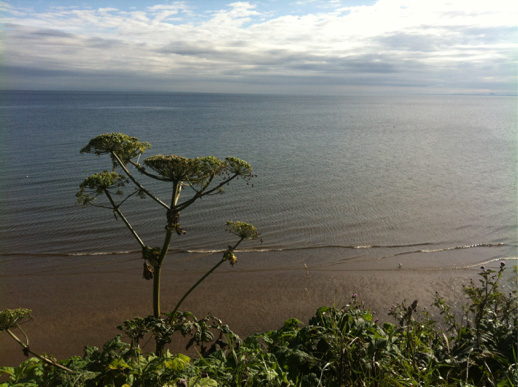The appearance of a Giant hogweed plant will change noticeably over the growing season. The information below is broken into descriptions of discrete sections of the plant to differentiate it from other plants which may share some similarities but not all of the features described below will be visible for the entire growing season and after early summer the size of the plant makes it difficult to confuse with anything else commonly found growing in the UK.




Giant hogweed leaves are divided into three or five lobes and sharply pointed with a spiky appearance and fine hairs on the undersides of the leaves and on the stem.
Early in the growing season these leaves bear a similarity to Common Hogweed (Heracleum sphondylium) and Cow Parsnip (Heracleum lanatum) which are related plants common in Europe and North America and frequently mistaken for each other. Careful inspection at this stage shows that Giant Hogweed tends to have a thicker stem, but this is only really useful to an experienced eye or you happen to have both species side by side for comparison. If you leave the plant for a few weeks the similarity soon passes. Giant Hogweed leaves will commonly grow to over 1m in width while it’s smaller relatives rarely exceed 50cm in width.
The stem can grow up to 10cm in width, is hollow and green with purple spots it’s also covered in hair like bristles which are commonly thicker and white in colour towards the base of the plant. Sap can be released upon touching the bristles or contact with a broken stem, and is a danger to humans and animals. The spots on the leaves and stems indicate where a bristle is growing. Stems also appear slightly ridged, this is particularly obvious on flower stems.
The plant is perennial which means that it grows in summer and dies back every winter, it’s also monocarpic which means that it only flowers once in it’s lifetime and then dies. However the plant will only flower when it has built up sufficient resources and it’s capable of delaying flowering for many years meaning that if it doesn’t reach maturity and flower the plant will simply die back at the end of the growing season and have another go the following year. From germination to flowering is usually two to three years but in adverse conditions this can be much longer.
Germination takes place in early spring and you can expect to see shoots in March to early April. Shoots will quickly form a rosette of leaves which will then grow to cover the ground with a dense cover, several thousand seedlings per m2 is not uncommon in mature stands. The majority of these plants will be shaded out by their siblings or mature plants from previous years and die but those that survive will re-grow as larger and more mature plants the following year. This means that once a stand is established there is a constant cycle of maturing plants.
The flower heads are probably the most distinctive aspect of a Giant Hogweed plant. Mature plants flower from mid-June to late July and the flower heads are large and white to off-white colour and form an umbrella shaped head of thousands of tiny flowers in clusters called umbels. Commonly there will be a large central umbel on the main stem and several smaller heads from branches which have split off further down the stem.
Stems can grow to 5m in height and a large stand of mature flowering Giant Hogweed will completely dominate an area, it can look like a throwback to prehistoric time.
Flowers will then become seeds which are dispersed between late August and October. The seeds (mericaps) are light brown to grey in colour, oval and very thin. They are 6-18mm and 4-10mm wide and easily dispersed by wind, water and human/animal interactions. Each plant can produce between 30 – 50,000 seeds and in mid to late autumn the ground around a mature stand of Giant Hogweed will be a carpet of dropped seeds.
Seeds can be dispersed over a wide area by the wind and water courses and are often transported by animal or human interaction. Railway lines and watercourses will quickly become over run by Giant Hogweed forming dense corridors as seeds are carried downstream or all over the place in the case of trains.
In winter the plants will die back to leave a rosette of dead grey leaves and stems with a central grey and woody stem.
2021
Giant Hogweed removal
Accurately identifying an invasive weed without any prior knowledge can be tricky for the lesser green fingered amongst us, especially when there is a health risk involved. This free eBook will help educate, identify, treat and address the dangers of Giant Hogweed.


